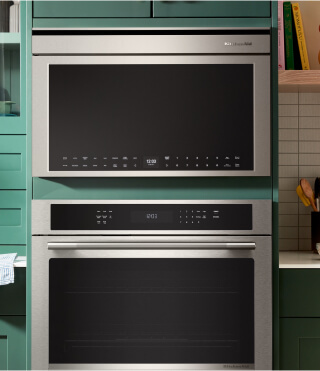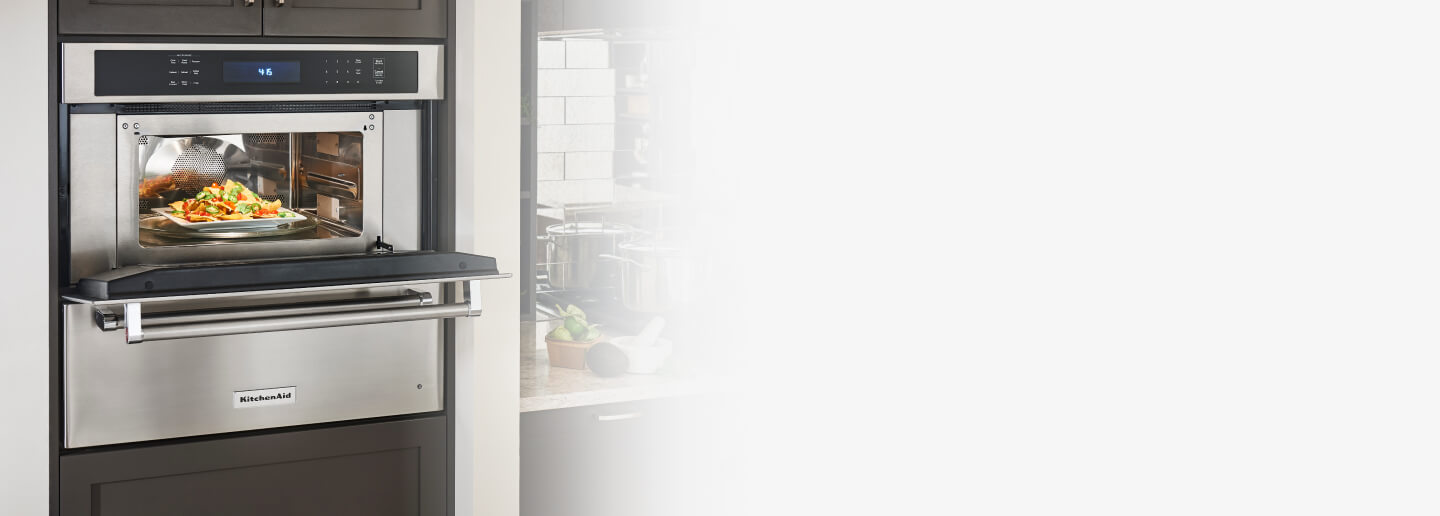
What is a microwave with steam cooking?
Microwaves with steam cooking settings use uniquely designed presets and sensors to help steam dishes like tender vegetables and flaky fish. Whether you're whipping up a quick meal or preparing something a bit more refined, a steam microwave oven offers versatility and precision.
Read on to discover how steam microwaves compare to traditional microwaves and steam ovens, learn four steps for using a steam microwave and find inspiration for steamed recipes.


What can you cook in a steam microwave?
Steaming food in the microwave can help clear up cooktop space, may preserve vitamins and minerals in your food, and often cooks dishes faster than boiling. You can experiment with steaming a wide variety of foods in the microwave, from vegetables and pasta to rice, fish or chicken. See the recipes below for more inspiration.
Appetizers and sides: Wake up your taste buds with appetizers and sides like steamed root vegetables or steamed sweet potatoes.
Main dishes: Try your hand at steaming entire entrees in your microwave when you use it to make steamed salmon or steamed pork.
- Desserts: Satisfy your sweet tooth when you steam desserts like pudding cakes.

Find your next microwave

Compare range hoods and microwaves
Shop KitchenAid® steam microwaves
KitchenAid® microwaves with the Sensor Steam Cycle let you customize the steaming process with functions that automatically set the time and power level based on the food type and doneness level you’ve selected. Plus, with the included steamer container, it’s even easier to get started.
How to use the sensor steam cycle on a microwave
Steam microwaves are designed to take the guesswork out of steaming your favorite foods. For a KitchenAid® microwave with the Sensor Steam/Simmer Cook Cycle, simply prepare your food, place it in the included steamer vessel with water and choose your desired settings. Reference your owner’s manual for more information about steaming, and learn more about each step below.
Prepare food: You can infuse steamed foods with flavor by adding seasonings, fresh herbs, sauces or butter, just like you might with other cooking techniques. Make sure you wash and evenly chop vegetables before steaming.
Add water to the steamer vessel: Add water to the base of the steamer vessel (see the chart below for guidance on specific amounts), then layer the insert on top of the base and fill it with prepared food. Place the lid on top and slide the vessel into the microwave.
If you don’t have the steaming vessel on hand, fill a microwave-safe dish with food and water, then cover the dish with microwave-safe plastic wrap and poke several holes in the top before placing it in the microwave.Select settings: Steam microwaves often come equipped with a variety of preset steaming options. On select KitchenAid® microwaves with the Sensor Steam/Simmer Cook Cycle, you’ll find presets for vegetables like cauliflower, asparagus or red potatoes, as well as various dried pasta types, fish, shrimp and rice. Choose the cycle best suited to your dish.
If you’re experimenting with steaming a food that doesn’t have a preset cycle, you can choose the Manual option and enter your desired cooking time on the keypad.- Remove dish: The steamer vessel may be hot after steaming, so use oven mitts to remove it from the microwave. Be sure to keep the lid on for the duration of the steaming process, since a sudden rush of steam can disrupt the microwave’s sensors. Once the dish is done cooking, angle the steamer lid away from you to open it.
See the chart below for more guidance on preparing food for steaming.
Steam microwave vs. microwave: what’s the difference?
Both traditional and steam microwaves rely on electromagnetic waves to heat food. Steam microwaves take it a step further with specialized features designed to fine-tune time and power (wattage) for various dishes. Traditional microwaves let you steam using a microwave-safe bowl and plastic wrap.
KitchenAid® microwaves with the Sensor Steam Cycle use sensors to detect when boiling water transforms into steam, then begins the countdown timer based on the microwave cavity’s steam levels and preset you’ve chosen. Microwaves with steam cooking can also include features for convection cooking, roasting, defrosting, air fry and more.
Steam microwave vs. steam oven: what’s the difference
Steam microwaves and steam ovens are both designed to fill the cooking cavity with steam and create a humid environment ideal for preparing vegetables, fish, rice and more. Both typically come with a steamer accessory that includes a perforated steamer tray for holding food above the boiling water below and a lid to hold the steam inside. This accessory is larger for the oven, letting you prepare more food at once. Learn more about how to steam in an oven.
Select KitchenAid® wall ovens feature Steam Assist Mode ideal for baked goods, breads and roasts, combining the dry heat of convection cooking with steam for a moist interior and browned exterior. The +Steamer Attachment—like the one included with this KitchenAid® wall oven—connects to a powered hub in your oven, giving you more control over the steaming process through the oven’s display.

KitchenAid® built-in microwaves
Seamless integration and professional design
Whether you need to reheat, steam or fully cook a meal, KitchenAid® built-in microwaves provide a versatile cooking space without taking up your counter space
Explore KitchenAid® microwaves
KitchenAid® microwaves are designed to elevate your cooking, offering a wide range of versatile features so you can explore a range of techniques. Select microwaves include convection cooking, a broil element, the Sensor Steam Cycle and air fry technology that make it easier to create anything from cheesy garlic bread to tender pot roast and more. And, with microwave hood combinations, as well as countertop and over-the-range microwaves to choose from, you can find the right fit for your kitchen’s layout.

KitchenAid® Hardware Accessory Kits
Curate the colors and textures that move you
From bold Black Ore to the inviting warmth of Bronze, mix and match handles and knobs to refresh your appliances and bring new energy to your kitchen


